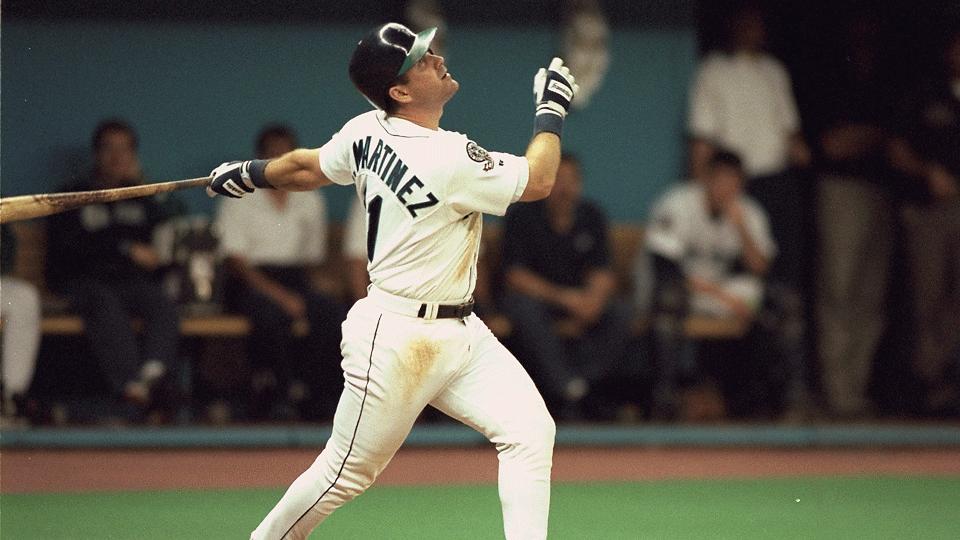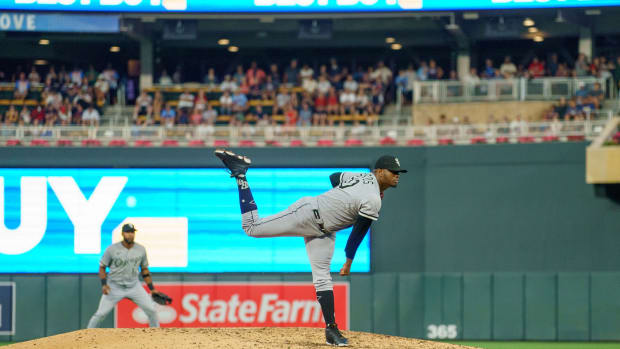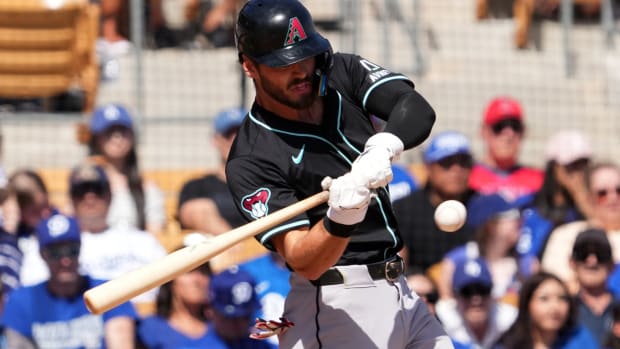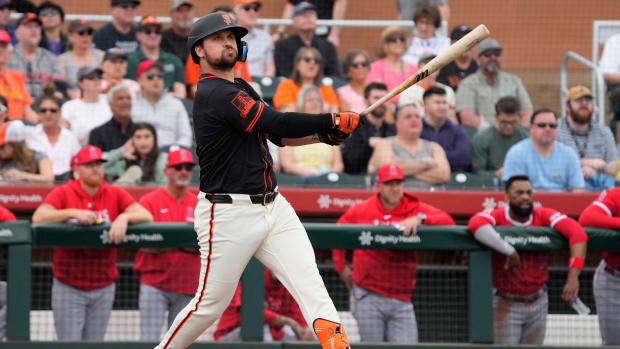
Hall of Fame rule changes a cruel twist to current crop of candidates
With much of the baseball world descending upon Cooperstown for this weekend's Hall of Fame induction ceremonies, the institution's board of directors announced the first change to the voting process since 1991: recently retired players will have a maximum of 10 years of eligibility on the Baseball Writers Association of America ballot instead of 15, with only the three players whose candidacies are beyond 10 years — and who clearly aren't getting in amid the current backlog — grandfathered. Without other changes to the voting process, this unilateral move is grossly unfair to the other 14 holdover candidates who had previously been presented to the voters as having 15 years to reach the necessary 75 percent threshold for election.
As long-term strategies for streamlining the voting process go, reducing the window of eligibility from 15 years to 10 itself isn't a bad thing. But without changing other key parameters of the process — namely, the 75 percent requirement and the 10-candidate maximum per ballot, both of which have been in place since the inaugural 1936 vote — this only reduces the likelihood of players from an already underrepresented era of getting their due.
The JAWS 75 for 75: Ranking the Hall of Fame's top players
Moreover, by not uniformly applying the grandfather clause to all of the eligible candidates, the Hall is playing favorites. The change takes aim at those players whose careers were centered in an era rife with the abuse of performance-enhancing drugs, yet one that lacked a functional policy of prevention and punishment against their abuse. The bulk of the blame for that total institutional failure should rightly be shared by the commissioner, the owners and the players' union, though it's a few individuals — some of them now Hall of Fame candidates — who are the focus of the public ire. With this rule change, all of the candidates whose careers extended beyond 1997 (seven years before random testing and suspensions were put in place) have had their eligibility truncated, regardless of whether they themselves have been connected to PEDs.
For its part, the Hall's two most publicly visible representatives denied the connection between the era and the eligibility change. Via the New York Daily News' Anthony McCarron:
"The steroid era had nothing to do with the decision,” said Jane Forbes Clark, the chairman of the board of the Hall of Fame.
Instead, the changes are about “relevance,” Hall president Jeff Idelson said. “In a study of voting over its history, it’s become evident, especially over the last 30 years, that the likelihood of election after 10 years is incredibly minimal."
"Incredibly minimal" is in the eye of the beholder. According to the press release, of the 211 players elected to the Hall of Fame for their major league service, 115 were elected by the BBWAA, 13 (11 percent) after their 10th year of eligibility.
Since the BBWAA returned to voting annually in 1966, it has elected 75 players, nine of whom (12 percent) were elected beyond year 10. Listed chronologically: Red Ruffing (1967, 15th year), Joe Medwick (1968, 14th year), Lou Boudreau (1970, 12th year) Ralph Kiner (1975, 15th year), Bob Lemon, 1976 (14th year), Duke Snider (1980, 11th year), Bruce Sutter (2006, 13th year), Jim Rice (2009, 15th year) and Bert Blyleven (2011, 14th year). The candidacies of the first five of those players extended back to the pre-1966 period, when the BBWAA voted only in even-numbered years.
Admittedly, not all of those players were particularly strong candidates, but by and large, they were stronger than numerous Veterans Committee choices made during the same time period. Via my JAWS system, which uses career and peak (best seven seasons) Wins Above Replacement totals to compare each candidate to the elected players at his position, Blyleven, Boudreau and Snider clear the JAWS standard at their position, while Kiner clears the peak standard; his career and Lemon’s were shortened at the front end by military service during World War II.
MLB Hall of Fame induction weekend: Read all about the incoming class
The three players grandfathered by the rule change are Don Mattingly, who's headed into his 15th and final year of eligibility, Alan Trammell, headed into his 14th, and Lee Smith, headed into his 13th; their careers ended in 1995, 1996 and 1997, respectively. None of them are close to having the necessary level of support. Mattingly received 28.2 percent of the vote when he debuted on the ballot in 2001, but hasn't been above 20 percent since 2002; he pulled in just 8.2 percent of the vote in 2014. Trammell — by far the most qualified of the trio according to my JAWS system, — peaked at 36.8 percent in 2012, his 11th year of eligibility, but was down to 20.8 percent in the most recent cycle. Smith, the best-supported of the trio during his ballot tenure but well below the JAWS standard, appeared to have a chance at enshrinement once he reached 50.6 percent in 2012; his share of the vote has waned in the past two years, falling all the way to 29.9 percent in the most recent cycle.
Hit the hardest by the rule change are these six players:
• Mark McGwire (career 1987-2001): Having admitted to using PEDs during the pre-testing era, McGwire has gotten the cold shoulder from voters. He peaked at 23.6 percent of the vote in 2008, but fell below 20.0 percent in 2011. He received just 11.0 percent of the vote in 2014 and was probably doomed to fall off the ballot before year 15 anyway. McGwire is below the career, peak and JAWS standards at first base, but not by much, though it's clear that his connections to PEDs trump his qualifications and historical importance in the eyes of voters.
• Tim Raines (1979-2002): Potentially the worst casualty of this change, Raines is well qualified for election, ranking eighth among leftfielders in JAWS, above that standard as well as the career and peak ones. He debuted with 24.3 percent of the vote in 2008, but his support has steadily climbed; he received 52.2 percent of the vote in 2013 but fell back to 46.1 percent in 2014, his seventh year of eligibility. He now has three cycles remaining instead of eight, and faces a very crowded field.
• Edgar Martinez (1987-2004): Another significant casualty of the change, Martinez clears the career, peak and JAWS standards at third base, where he played 564 of his 2,055 career games before injuries led the Mariners to park him at designated hitter. He made a solid ballot debut at 36.2 percent of the vote in 2010, indicating the potential for a late-eligibility induction, but he hasn't climbed higher than 36.5 percent. In 2014, his fifth year of eligibility, he fell to 25.2 percent, and now his window of remaining eligibility has been cut in half; instead of 10 cycles remaining, he now has five. Ouch.
The JAWS 75 for 75: The Hall of Famers who just missed the cut
• Fred McGriff (1986-2004): Though he clubbed 493 homers during his career, McGriff is far short of all three standards on the JAWS front, and even before the change, his candidacy was in rough shape. He debuted at 21.5 percent in 2010, peaked at 23.9 percent in 2012, but fell to 11.7 percent in 2014, his fifth year of eligibility, marking him as very likely to fall off well before year 15.
• Jeff Bagwell (1991-2005): Despite a career that was curtailed by shoulder woes, Bagwell ranks sixth among first basemen in JAWS, clearing the standard on all three fronts by significant margins. While he admitted to using androstenedione in the pages of Sports Illustrated back in 1999, the drug was not only allowed under MLB rules, it was legal in the U.S. until 2004. For some voters, a whisper campaign that he used PEDs beyond that — without any actual evidence of doing so, to say nothing of the absence of penalties — is enough to withhold their support, but he nonetheless appears to be on track for eventual election. He debuted on the 2011 ballot with 41.7 percent, climbed to 59.6 percent in 2013, but fell back to 54.3 percent in 2014, his fourth year of eligibility. He now has six chances remaining instead of 11.
• Larry Walker (1989-2005): Though he battled myriad injuries during his career, Walker was an elite hitter who ranks 10th among rightfielders in JAWS, above the standard; he clears on peak as well but falls half a win short on career. Despite no connection to PEDs, he has struggled to gain support from the voters, debuting at 20.3 percent in 2011, peaking at 22.9 percent he following year, but falling all the way to 10.2 percent in 2014, his fourth year of eligibility. Like Bagwell, he has six shots remaining instead of 11, though he almost certainly won't build the necessary support in that time.
None of the other holdovers has had more than two turns on the ballot thus far. Of that group, 2014 second-year candidates Craig Biggio (74.8 percent) and Mike Piazza (62.2 percent) received strong support in the most recent cycle, with the former falling a mere two votes short. Among other second-year candidates, Roger Clemens (35.4 percent), Barry Bonds (34.7 percent), Curt Schilling (29.2 percent) and Sammy Sosa (7.2 percent) all saw their support decrease from 2013 levels. Of those players, only Schilling hasn't been connected to PEDs, though none ever tested positive during the punitive phase of MLB's testing regime; all but Sosa have the JAWS stamp of approval. First-year candidates Mike Mussina (20.3 percent) and Jeff Kent (15.2 percent) made inauspicious debuts on the ballot, and now face significantly longer odds in their remaining nine years; Mussina ranks 28th among starting pitchers and clears the standards on career, peak and JAWS fronts, while Kent ranks 18th among second basemen and falls short on all three fronts.
In all, a whopping 14 candidates on the 2014 ballot cleared the JAWS standard at their position, the highest total under the modern voting system. With just 10 spaces on the ballot, the situation became unmanageable enough that at the most recent winter meetings, the BBWAA established a committee — chaired by past president Susan Slusser — to study possible changes to its voting process, though the final authority on any recommended changes rests with the Hall.
(In the interest of disclosure, I can say that I'm on that committee, which was not consulted with regards to this change. Under current BBWAA rules, I am not eligible to vote until the 2021 ballot.)
While the electorate's split regarding PED users has helped create a backlog of qualified candidates, the Hall's failure to adjust the voting rules has done so as well. When the rules were put in place in 1936, the major leagues consisted of 16 teams. Today there are 30. The squeeze has contributed to lower levels of representation for modern players — not just those who played in the 1990s but in the 1970s and 1980s as well. Limiting the field to those elected by the BBWAA, my research shows that the average number of active Hall of Fame players per team per season from 1923 through 1941 is 1.5. From 1946 through 1988, that level falls to 1.34; it's been below 1.0 since 1988, and below 0.5 since 1993. Similarly, research by FanGraphs' David Cameron shows a drastically smaller percentage of players born after 1951 are enshrined relative to those born prior, whether one considers all players with major league service or just those whose body of work is roughly equivalent to 10 years in the majors (above 5,000 plate appearances or 2,000 innings pitched).
The Hall's rule change increased the likelihood of those trends continuing, a problem that could exacerbate the institution's decline in annual attendance, which according to the New York Times has fallen every year since 2005. Fewer players getting elected almost certainly means fewer visitors to the museum, fewer generations of fans sharing the stories of the Hall of Famers they watched to the next generation, something that won't help given the aging demographic base of the game’s television audience.
On a lesser note, along with the change in eligibility window, the Hall also announced that it is installing a new balloting and registration process for BBWAA voters. They will have to complete a registration form and sign a code of conduct, and their names (but not their actual votes) will be made public with the election results. McCarron called this "the Dan Le Batard rule," after the writer who gave his ballot to Deadspin and was subsequently suspended from the BBWAA for one year and permanently stripped of his vote. The new rule appears to be more symbolic than anything else, formalizing the Hall's right to strip the vote with or without the BBWAA's sanction.
In all, the timing of the Hall's announcement is curious, as it has diverted attention away from this year's honorees. In addition to Glavine, Maddux and Thomas, managers Bobby Cox, Tony La Russa and Joe Torre are being inducted, while New Yorker writer Roger Angell is receiving the J.G. Taylor Spink Award, Rangers broadcaster Eric Nadel the Ford C. Frick Award and Joe Garagiola (in absentia) the John J. “Buck” O’Neil Lifetime Achievement Award. The institution should have let this weekend belong to those individuals and saved the announcement of changes until a later date. More importantly, it should have handled those changes differently so as to give candidates their fair shot at receiving the game’s highest honor.


































